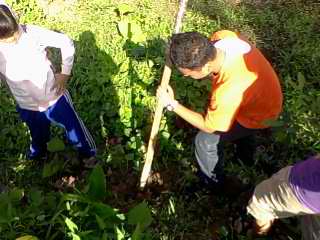FUTURE VISIONS.............
What will you be doing on this day in the year 2030? It's only 19 years away. Try to imagine how life would be then. What kind of world will it be? Will the world be in the middle of a major environmental catastrophe? Or maybe we'll have solved our environmental problems?Maybe there 'll have been a nuclear war? Or will there be a world peace?
And what will have changed in our homes and schools? Look around your house and your classroom. Which of the gadgets you use everyday do you think will still be around in 2030? Clock radios? Microwave ovens? Telephones? Books? The Helix magazines?
If you were in the age as now, but living in the year 2030, what would your room look like?How might your life be different?There is no way we can know for sure but we can guess.
You don't need to work at home for the robotics technology will provide your house helpers to do domestic chores for you.
Want to go shopping ? No problem. Slip into a virtual shopping arcade and spend some electronic pocket money buying a new pair of runners. Or buy the latest album, you won't have to wait ..the shop can send it straight to your computer..or go to a virtual concert- even take part in a virtual music video.
Instead of going to school everyday , you could take your lessons at home...join a virtual Chinese language class taught from Hongkong or drop into a Californian school to see how they teach genetics.
CRUISING THE SUPERHIGHWAYS
By early next century ambulances racing to hospital would be able to beam images of their patients ahead of them so doctors could see what was wrong before they arrive.!
People would be able to shop from home in virtual supermarkets, walking around shops ,choosing what they want and paying for it, electronically at virtual check outs. A consumer might even decide his or her own car or bicycle from home then order it to be made.
Impossible? Not according to Dr. Bob Frater.,the director of the CSIRO's Institute of Information Sciences and Engineering . Bob said "wireless" technology would improve so much that even videos and pictures could be beamed without wires in a split of a millisecond. He also said cheap microprocessors would make possible a flood of micro sensors which would find their way into everyday objects . Computer chips in 2030 would be many times more powerful and far more cheaper, than they were now.
READY TO ORDER
And what about other things? there's no point in trying to guess what fashions will be like or hair styles. But it's far bet that biotechnology in the year 2030 would take the lead . You might even be able to double a bit in virtual genetic engineering from your home computer.
You want hamburger to be delivered?Dial the hamburger factory and order it just how you like it or you could just program the fermentation vats to produce it for you. And maybe by 2030 all the foods you eat might be genetically engineered and modified to taste better , to produce higher yields, pest resistant ,grow fast and survive tough conditions. And there might be "pharmers" in 2030, people who grow genetically engineered crops to produce pharmaceuticals and other chemicals and materials for use in medicine and industry.
Your home pets might be a zebra-striped miniature elephant or a cute kitten that has been engineered genetically so it will never grow up.
WHAT CAN HAPPEN IN 19 YEARS?
I don't know. Nobody does. But i do know the world has changed and it has changed a lot!
The world in 2030 will be how we make it. World peace...world war..global environmental disasters and solutions don't just happen- people make them happen. People like you. Everyday you are helping create the future. It's a safe bet too that science and technology will play a big part in all our future.




























